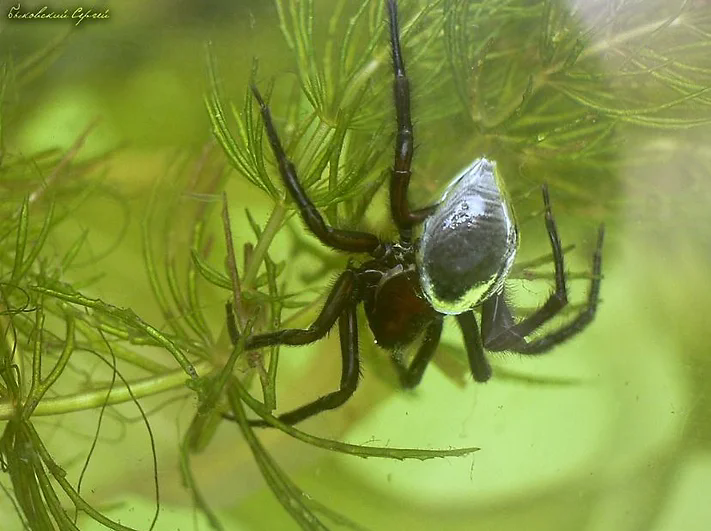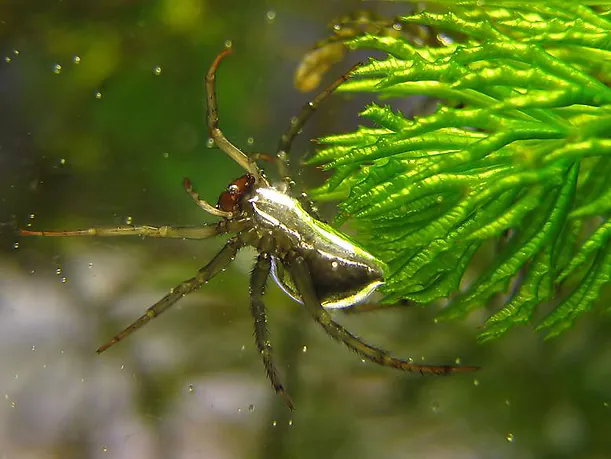
The Water Spider, (Argyroneta aquatica), lives underwater, where it builds a bell-shaped home of silk and fills this structure with air that it carries down from the surface. It is common in ponds and lakes of temperate Europe and Asia. The diving bell spider or water spider is the only species of spider known to live almost entirely under water. It is the only member of the genus Argyroneta. When out of the water, the spider ranges in colour from mid to dark brown, although the hairs on the abdomen give it a dark grey, velvet-like appearance.
In Australia, one type of Water spider frequents fresh or brackish water, running across the surface, feeding on floating insects. If they break the surface and fall in, air trapped in the hairs on the abdomen allows them to breathe underwater.
The female makes a “nursery” shelter for her egg sac. In the picture, a female water spider of the family Argyronetidae tends its egg cocoon while underwater in a freshwater pond.
Water spiders use silk to house their eggs while underwater.
The Giant Water Spider (Megadolomedes australianus) when grown to its full size is about the size of 50 cent piece. Its leg diameter can be from that of a pin to a matchstick. It has as mottled dark abdomen and its head has as silver or dark gold border.
Its habitat is on creek banks and streams and it hunts on water. It is most commonly found in summer and there are many species Australia-wide.
It builds no web as it is a rover but the female builds a nursery retreat for her egg sac. If bitten, you will experience mild local pain.
The water spider lives underwater, building a bell-shaped web between underwater plant stems. It can be spotted as it comes to the water’s surface to trap air in the hairs on its body, which it takes down to fill the web, or ‘diving bell’ (hence its other common name of ‘diving bell spider’). It lives in this large air bubble during the day, and hunts at night. Mating takes place within the web retreat and the female builds a special egg chamber in which she lays and guards her eggs. Water spiders can be found in weedy lakes and ponds, and very slow-flowing streams.

How to identify
The water spider is the only spider that spends its life underwater. If caught while pond dipping, it can be recognised by the silvery air bubble it carries on the hairs on its body. Out of the water, it looks grey-brown. Males are larger than females.
Understanding the Water Spider’s Aquatic Lifestyle
Water spiders are a fascinating arachnid species that have adapted to thrive in aquatic environments. These unique creatures, also known as diving spiders, possess remarkable abilities that allow them to submerge themselves underwater for extended periods.
Habitat and Behavior
Water spiders are found in freshwater habitats such as ponds, lakes, and slow-moving streams. They construct underwater “diving bell” nests made of silk, which they fill with air to create a dry, safe space for resting and raising their young. These spiders are skilled divers, using their hydrophobic (water-repelling) legs to trap air bubbles and transport them back to their nests.
Species and Facts
There are several species of water spiders, with the most well-known being the European water spider (Argyroneta aquatica). These spiders can remain submerged for up to 24 hours, thanks to their ability to extract oxygen from the water through a process called plastron respiration. Additionally, water spiders are known to prey on small aquatic creatures, such as insects, tadpoles, and small fish.
Understanding the unique adaptations and behaviors of water spiders provides valuable insights into the remarkable diversity of life found in aquatic ecosystems.
